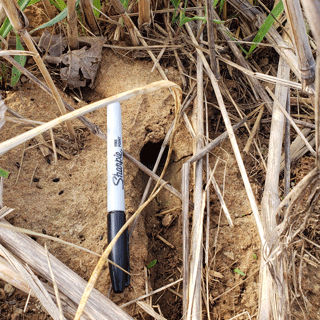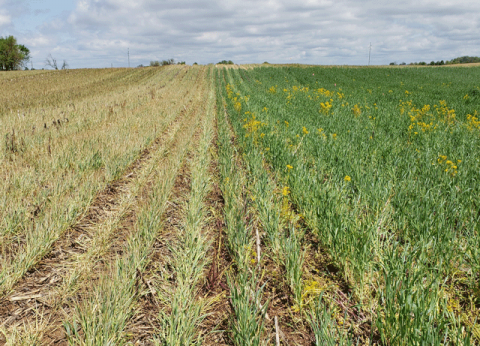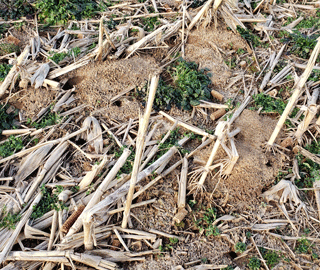Vole Management Strategies
Vole Information:
Click on the following links to learn more:
Modify habitat:
Depending on the level of infestation and the plot size you wish to manage, habitat modification may be a viable method to mitigate vole damage. Examples of habitat modification range from hay removal and low mowing to herbicide application. With this said, they all attempt to achieve the same goal of removing food and cover. Removing food and cover may cause vole populations to move to more suitable habitat, starve, or be more easily preyed upon by predators such as hawks, snakes, foxes and coyotes. Habitat modification may be effective on small scales but may become more expensive or time consuming when applied in larger agricultural applications such as row crop systems and should therefore be targeted towards areas of highest impact.
Exclusion:
Excluding voles may be an effective means of damage prevention depending on the size of the exclusion zone.  Voles can be effectively excluded from damaging plants such as trees by circling the trunk with plastic cylinders or hardware cloth of ¼-inch or less. When doing this, significant space should be left between the protective material and the trunk to allow for future growth. The protective material should also be buried to keep voles from simply moving under the material. Similar methods may be used to exclude voles from a plot by fencing in the area with ¼-inch, or less, mesh and burying it 6 inches below ground to prevent voles from simply burrowing under. While this may be effective on a small scale, the labor and time associated with this method often eliminates it from being used in larger applications such as row crop systems.
Voles can be effectively excluded from damaging plants such as trees by circling the trunk with plastic cylinders or hardware cloth of ¼-inch or less. When doing this, significant space should be left between the protective material and the trunk to allow for future growth. The protective material should also be buried to keep voles from simply moving under the material. Similar methods may be used to exclude voles from a plot by fencing in the area with ¼-inch, or less, mesh and burying it 6 inches below ground to prevent voles from simply burrowing under. While this may be effective on a small scale, the labor and time associated with this method often eliminates it from being used in larger applications such as row crop systems.
Repellants:
Vole repellent options include products that are distasteful to the animal as well as products that increase the target animal’s stress level. The first category of repellants is comprised of products containing thiram or capsaicin that aim to deter voles from consuming the plants they are applied on. The second category of repellants is comprised of products such as fox and coyote urine which may increase voles stress levels and depress reproduction rates. When using any repellent, always consult the label for application instructions and avoid application on any part of a plant that may be consumed by humans unless the label expressly states that this is unnecessary. While repellents may prove effective on a small scale or over short periods of time, the need for reapplication after precipitation events, as well as the time and labor associated with their use make them less feasible on larger scales and not recommended in row crop systems.

Trapping:
Trapping voles is another method of damage control that may be effective depending on the scale it is applied. While placing traps may be time consuming it can prove very effective on smaller plots or lawns. When using traps to mitigate vole damage, traps should be placed in or along holes and runways. Traps set along runways should be placed with the trigger in the runway and the trap perpendicular to the runway. It is not necessary to bait traps; however, if you wish to do so a mix of peanut butter and oatmeal on the trigger will suffice. Deploying traps in holes or in an enclosure sized for a vole may mitigate trapping of non-target species and therefore bolster effectiveness. Traps should be checked regularly and moved if nothing is caught within 48 hours. With this in mind, trapping efforts as a whole may continue as long as the target species is being captured. While traps may be effective on small plots and populations, the time and labor required for their successful deployment must be taken into account when applied to larger plots. These considerations combined with the reproductive capabilities of rodents make trapping inadvisable for large row crop systems.
Toxicants:
Toxicants offer perhaps the most efficient results for vole damage control at a large scale. With this said, it is important to keep in mind that they also pose the highest risk of accidental poisoning of non-target species and humans. It is therefore important to consult your state and local regulations before purchasing or applying toxicants. Perhaps the most commonly used toxicant for vole population control is zinc phosphide. Zinc phosphide is a restricted use toxicant and can only be used in above ground applications by a registered applicator. Zinc phosphide often comes in a pellet bait form that should be applied by hand on holes or runs, or drilled to avoid consumption by non-target species or humans. It may be used in a variety of non-food agricultural scenarios such as no-till corn and dormant orchards, but is limited to food applications such as grapes and sugarcane. Other toxicants include anticoagulants that may require multiple consumptions before becoming fatal to the target species. Depending on state and local regulations, some toxicants may be broadcast per their label instructions; however, this may increase the amount of toxicant needed to achieve the same impact on the vole population and raise the risk of impacting non-target species. While toxicants may offer an efficient means of vole population control, regulations and label instructions must be followed to ensure minimized risk of human and non-target species contact. For these reasons, application limitations restrict toxicants from being used in most row crop systems.
Alternative Feeding:
Alternative feeding is essentially the application of some other food source to remove the need for voles to consume crop plants. This may prove effective in mitigating crop damage, as voles are less likely to consume crops if they have a plentiful food supply. This can be applied in scenarios such as Roundup Ready® soybeans, where standard soybeans can be broadcast evenly prior to seeding and (if any seeds germinate) controlled later with Roundup®. Research suggests that one bushel of soybeans, evenly spread, may be sufficient. In this scenario, vole damage may be mitigated by the additional food provided early since voles generally feed on new leaves and not the whole plant once the plants are established. In this way, alternative feeding may mitigate crop damage during this critical seedling period and may be useful in row crop systems.
Raptor Perches:
Raptor perches are an effective way to encourage vole predators, such as hawks and owls, to frequent a given location. This may aid in deterring voles from colonizing an area or help to control small populations. With this said, while raptor perches are encouraged in large scale applications such as row crop systems they are likely most effective when combined with other measures such as habitat modification. Use of rodenticides is discouraged if you are placing raptor perches as rodents who consume the rodenticide will be eaten by the raptors and cause the raptor’s health to be impacted indirectly by the rodenticide.

Conclusions/Integrated Methods:
Rodents such as voles may be beneficial, in certain numbers, due to their proclivity for consuming a variety of insects and agricultural weed seeds. When found in low densities, these possible benefits should be considered along with all other pertinent factors.
When attempting to confront issues of vole damage it is generally most effective to employ an integrated pest management approach. This entails assessing the problem and coming up with a targeted strategy for each instance. Often times, the most effective way to mitigate vole damage is to employ a combination of the damage prevention measures listed above. For instance, the use of toxicants may prove more effective over the long term when combined with habitat modification measures such as low-mowing or herbicide application. Given a certain scenario this two-pronged approach may be more effective at controlling the existing vole population while at the same time limiting their resources and encouraging persisting individuals to leave. In the end, preventing vole damage is a multifaceted undertaking that requires not only an understanding of voles and your particular situation, but also an integrated management plan over potentially several years.
